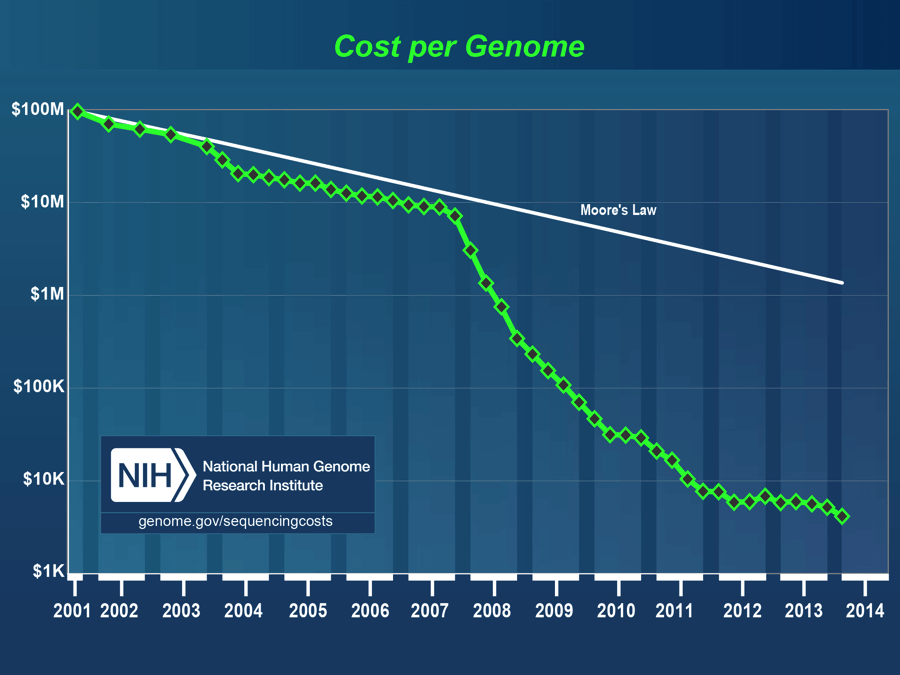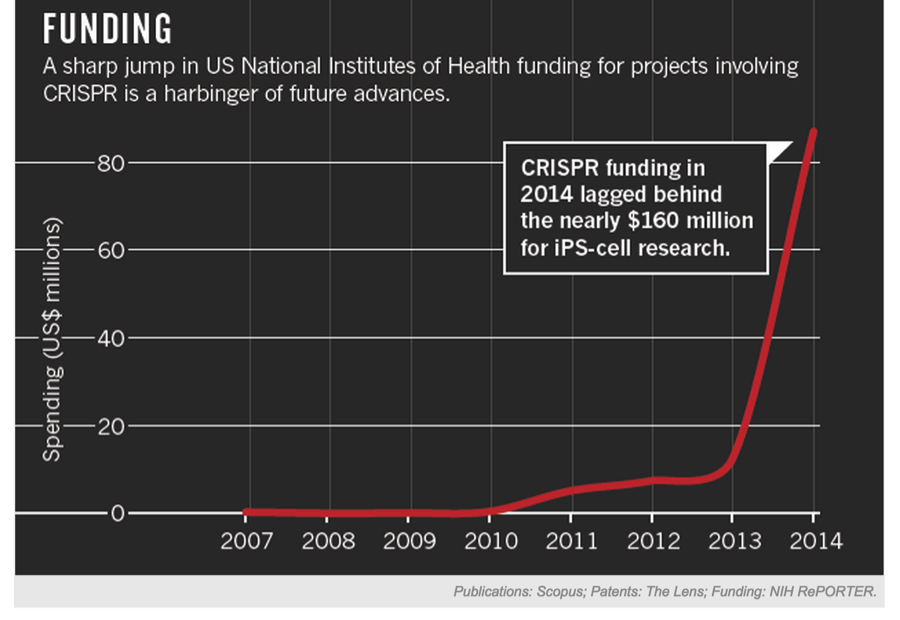Humanity is moving from evolution by natural selection (Darwinism) to evolution by intelligent direction.
For most of human history, our average age was only about 26 years old.
We would procreate at age 13, live just long enough to help our children raise their children, and then, on average, die at age 26 (so we were no longer taking food from the mouths of our grandchildren).
It was through technological innovation — sanitation and germ theory — that we moved life expectancy from 26 to the mid 50s. Recently, because of modern medicine’s progress in treating heart disease and cancer, we’ve bumped up today’s global average human lifespan to 71 years.
But this is just the beginning.
Advances over the next 10 to 15 years will move life expectancy north of 100.
This post is about advances in reading, writing, and building elements of the human body.
Reading – Sequencing the Human Genome
Your genome is the software that runs your body.
It is composed of 3.2 billion “letters,” or base pairs, that code for everything that makes you “you” — your hair color, your height, your personality, your propensity to disease, your lifespan, and so on.
Until recently, it’s been very difficult to rapidly and cheaply “read” these letters and even more difficult to understand what they do.
In 2001, my friend and Human Longevity Inc. co-founder Dr. J. Craig Venter sequenced the first complete human genome. It took about a year and cost $100 million.
Since then, the cost to sequence a genome has been plummeting exponentially, outpacing Moore’s Law by almost 3x (take a look at the graph below).

Today, the cost to sequence a full human genome is about $1,000.
This cost trajectory is unheard of, and it’s allowing us to do some very useful and productive things.
- Data Mining + Genomics: We can now fully sequence millions of individuals’ full genomes, and then mine all of that data to translate what the genome means. Each person’s genome produces a text file that is about 300 gigabytes. When we compare your sequenced genome with millions of other people’s genomes and other health data sets (like your microbiome, metabolome and MRI data), we can use machine learning techniques to correlate certain traits (eye color, what your face looks like) or diseases (Alzheimer’s, Huntington’s) to factors in the data and begin to develop diagnostics/therapies around them.
- N-of-1 Care: This is one of the most powerful and important changes coming in healthcare. When we understand your genome, we’ll be able to understand how to optimize “you.” We’ll know the perfect foods, the perfect drugs, the perfect exercise regimen, and the perfect supplements, just for you. We’ll understand what microbiome types (gut flora) are ideal for you. We’ll understanding which diseases and illnesses you are most likely to develop, and we’ll be able to prevent them from developing (rather than trying to cure them after the fact). Right now “healthcare” is actually “sick care” — your doctor tries to find quick fixes to make you feel better. With genomics, we’ll tackle the root of the problem and eventually eliminate disease altogether.
Now that we can read the genome, let’s talk about changing it.
Writing – What Is CRISPR/Cas9?
This past week, scientists from London’s Francis Crick Institute applied for approval to edit genes in human embryos. If approved, it will be the world’s first approval of such research by a national regulatory body.
Last April, a team out of Guangzhou, China reported that they’d been able to edit the genomes of human embryos.
What’s powering these advances?
It’s a new gene splicing technique called CRISPR/Cas9, and it’s changing the game.
CRISPR stands for “Clustered Regularly Interspaced Short Palindromic Repeats.” It is a strand of DNA that was found in 1987 to be part of a bacterial defense system.
The CRISPR/Cas system (Cas stands for “CRISPR associated” genes) was found in prokaryotic bacterial cells to identify and splice *specific/targeted* foreign genetic material that may be harmful to the bacterium.
It turns out that we can actually use this same mechanism to target and splice specific strands of our DNA — in other words, the CRISPR/Cas system is a way to **edit** our genome.
We can remove specific sequences, and we can insert specific nucleotide modifications at specific target locations.
Most importantly, unlike other gene-editing methods, it is cheap, quick, easy to use, and more accurate than previous methods, and as a result, CRISPR/Cas has swept through labs around the world as THE way to edit a genome.
With CRISPR, we will soon have the tools to eliminate diseases, create hardier plants, wipe out pathogens and much, much more.
Take a look at the funding that has poured into CRISPR over the last few years.

Hundreds of labs around the world are exploring new applications for the CRISPR/Cas system, and we expect to see more and more of these applications hitting the market in the next decade.
Building — Stem Cells Will Save Your Life…
You are a collection of over 10 trillion human cells.
Every one of these cells — those in your brain, lungs, liver, skin, and everywhere else — derives from a single pluripotent type of cell called a stem cell.
Stem cells have the remarkable ability to “differentiate” into any other type of cell in the body. After our body has developed, among our ten trillion fully differentiated human cells (skin, heart, muscle, kidney) remain a population of quiescent stem cells waiting to be called into action to help repair damaged tissue. These stem cells reside everywhere: in our bone marrow, in our fat, and in every single tissue compartment.
Today, in various locations around the world, researchers and physicians inject stem cells into areas of damage, and explore stem cell therapeutics around heart disease, brain disease, diabetes, cancer treatment, arthritis, spinal cord injuries, burns, macular degeneration, and much more.
Stem cells are being used in cancer research: “By studying adult stem cells to learn more about the genes involved in self-renewal, it may be possible to identify new molecular targets for drug and immune therapies that destroy the self-renewing cancer stem cells.” (Stanford Research)
Stem cells are being used to regenerate tissue and literally rebuild organs. Incredible work at companies like United Therapeutics and Synthetic Genomics are working on being able to regrow you a set of lungs this decade, and soon thereafter, any organ you may need.
There is a severe shortage of acceptable donor organs. With your stem cells, we can take a liver from a pig, for example, melt away the living cellular tissue, leaving only the collagen scaffolding, and then introduce your stem cells, which will then repopulate the organ, growing on the scaffolding into a perfect liver replacement, tailor-made for you.
We are living in the era of stem cell therapeutics… and the implications are staggering.
In Conclusion
Healthcare today is like a repairman who is trying to constantly fix a leaky roof by putting a bucket under the leak. Healthcare tomorrow is like using a scanning device to find the weakest part of the roof and reinforce it before the leak begins.
In the next decade, advances in genome sequencing, data analytics, synthetic biology and stem cell therapeutics will allow us to tackle the roots of the problems.
We are headed to a world without chronic diseases, with longer, healthier lives, and with personalized care for everyone on the planet.
Image Credit: Shutterstock.com



